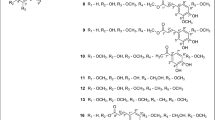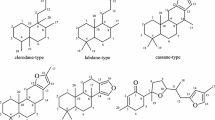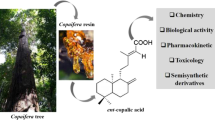Abstract
To this day, since about 50% of all medicines are derived from natural sources, natural product chemistry, especially the search for biologically active natural components, remains extremely important (Newman and Cragg in J Nat Prod 83:770–803, 2020). In this review, we deal with our continuing research work for promising constituents from plants collected in the Ryukyu Archipelago. The isolation of islands in the archipelago by the sea or by straits gives rise to endemic plant species that are unique to the islands. The structural diversity of the constituents produced by this unique flora is of great scientific interest in various aspects, including chemical structures, biosynthesis, and biological activities. The components from this structural diversity have great potential as new pharmaceutical seeds. In our continuing studies, we have successfully investigated new but extremely unusual diterpenoids: crotofolanes and their rearranged varieties (nor-crotofolane, trinor-crotofolane, neocrotofolane) and a glycoside with a new skeletal diterpenoid (isocrotofolane glucoside) from Croton cascarilloides. This review summarizes our reports on the investigation of crotofolanes as well as those on crotofolanes by other research groups.
Graphical Abstract

Similar content being viewed by others
Avoid common mistakes on your manuscript.
Introduction
The Ryukyu Archipelago, which extends about 1000 km from the main island of Kyushu to the Sakishima (Yaeyama) Islands, is crossed by the Watase Line south of Yakushima Island and the Hachisuka’s Line south of Okinawa Main Island, dividing their fauna into unique areas. Similarly, their flora is divided into the Sohayaki (Kyushu) and Ryukyu regions at the Watase’s Line. There grow also many subtropical and tropical plants native to Ryukyo region. The Sakishima Islands, several hundred kilometers away from the south end of Okinawa Main Island, have a tropical-like flora, including mangroves, and the unique floral resources of the Miyako, Ishigaki, and Iriomote Islands are highly valuable as research materials for natural products chemistry. The components of structural diversity produced from plant resources in the Ryukyu Archipelago are far beyond the imagination of mankind, and the isolation of novel components is expected. Based on this point of view, the authors have been conducting research on natural products chemistry with novel molecular structures and remarkable biological activities from plants native to the Ryukyu Archipelago.
In this paper, we reviewed the chemical structures of unusual new diterpenes obtained in the course of our research: crotofolane and its rearranged varieties (nor-crotofolane, trinor-crotofolane, neocrotofolane) and a new skeletal diterpene glycoside (isocrotofolane glucoside). A summary of reports on crotofolane by other research groups is given as well.
Crotofolane
We have studied the diversity of subtropical and tropical plant resources that produce unexpected constituents. In particular, we have searched for unutilized plant resources in the Ryukyu Archipelago for new components, and conducted bioassays to search for the biologically active components contained in them. In the course of this research, we succeeded in isolating some diterpenoids with a skeletal structure “crotofolanes,” which have rarely been reported, from Croton cascarilloides, collected in June 2004 at Kunigami-gun, Okinawa, Japan.
Crotofolane, which is a diterpene biosynthesized from cembrane via casbane and lathyrane through cross-annular cyclization, was first isolated as crotofolin A (1) in 1975 by Chan et al. from C. corylifolius [2]. After that, crotofolins B, C, and E (2–4) were isolated from C. corylifolius by Burke et al. in 1979 [3], crotoxides A and B (5, 6) from C. dichogamus by Jogia et al. in 1989 [4], and crotohaumanoxide (7) from C. haumanianus by Tchissambou et al. in 1990 [5]. Only these seven crotofolanes were reported, making them difficult to be recognized as a family of compounds (Fig. 1). The structure is characterized by tricyclicity, with a fused structure of five-, six-, and seven-membered rings as the basic skeleton. As compounds of similar structure, phorbol derivatives classified in tigliane, which comprises tetracyclic diterpenes having a basic structure of fused five-, seven-, six-, and three-membered rings, are known to possess remarkable biological activity. The authors have focused on the rare diterpene crotofolanes and succeeded in isolating and determining the structures of 22 crotofolanes, as shown in Fig. 2 [6,7,8,9,10]. First, the structures of 8 and 9 were analyzed by the one- and two-dimensional NMR spectra, and they were deduced as crotofolanes, which comprised fused five-, six-, and seven-membered rings and an additional γ-lactone ring. Their relative steric structures were finally confirmed by the X-ray crystallographic technique since both compounds gave high-quality crystals for analyses (Fig. 3). Meanwhile, 2-methylbutyric acid obtained from the hydrolysis of 8 and 9 as well as the commercially available (S)-( +)-2-methylbutyric acid were subjected to HPLC analysis with an optical rotation detector. As a result, the absolute configuration of 2-methylbutyric acid from 8 and 9 was determined to be S. This experiment was the first determination attempt of the absolute configuration of crotofolane diterpenoid. In addition, for determining the absolute configuration of other crotofolanes, a more general method is used. The positive Cotton effect in the ECD spectra derived from the α,β-unsaturated γ-lactone moiety empirically indicated that the absolute configuration at the 9-position was S [11, 12]. The structures of crotofolanes with double bonds at the various positions and epoxy rings, such as 18, 22, 29 and 23, 24, 27, 28, respectively, were also carefully determined. Investigation of the absolute structure of compound 18 was determined by X-ray crystallographic analysis (Fig. 4), followed by application of the modified Mosher’s method [13]. Compounds 22, 23, 27, and 28 were expected to be formed by the cleavage of the epoxy ring between C-5 and C-6. To confirm the geometry of these hydroxy groups; thus formed, an X-ray crystallographic analysis of crotocascarin N 5,9,11-tri-O-acetate (23a) was performed (Fig. 5), and the absolute configuration of 23 was determined to be the same as those of other crotofolanes, deduced from the positive Cotton effect at 254 nm in the ECD spectra and chirality analyses of the 2-methylbutyric acid moiety by HPLC.
Rearranged crotofolane (nor-crotofolane, trinor-crotofolane, neocrotofolane) and novel skeletal diterpene (isocrotofolane)
The authors also report the rearranged crotofolanes nor-crotofolane [crotocascarins α‒γ (30–32)], trinor-crotofolane [crotocascarins δ (33)], and neocrotofolane [neocrotocascarin (34)] as well as a novel skeletal diterpenoid glycoside [isocrotofolane glucoside (35)], as shown in Fig. 6. The ring structures were analyzed carefully since these NMR spectra were similar to those of crotofolanes. Both 30 and 34 acetate (34a) were obtained as high-quality crystals, and their structures were confirmed by X-ray crystallography (Fig. 7). Thus, the structures of 30 and 34 were determined to be nor-crotofolane and rearranged crotofolane (consisting of five-, six-, and six-membered rings and a γ-actone fused together) and to be neocrotofolane (a rearranged crotofolane consisting of five-, six-, and seven-membered rings and two γ-lactones). Based on the extended NMR spectral analysis, 35 was determined to be a glycoside of isocrotofolane, a new skeleton with an isopropyl group at the 9-position, derived by a different cleavage scheme from that of the crotofolane skeleton (as described in a later section, Consideration of biosynthetic pathways). For 33, in the latest report, its absolute configuration was determined by comparing the experimental ECD spectrum with the TD-DFT-calculated ECD spectrum (Fig. 8) [14].
Consideration of biosynthetic pathways from crotofolane to nor-crotofolane, trinor-crotofolane, and neocrotofolane
The presumed biosynthetic pathways of the rearranged crotofolanes are shown in Fig. 9. Note that the biosynthetic pathways of 30 and 34 are presumed to be followed by different cyclization sites, as shown in Routes a and b (Fig. 9) during recyclization, after cleavage of the 9/10 C–C bond of 9. Furthermore, 33 is presumed to have followed a biosynthetic pathway in which the acetyl group at the 8-position of 30 is replaced by a hydroxy group. The presumed biosynthetic pathway for the isocrotofolane skeleton is shown in Fig. 10. The relationship between rhamnofolane and daphnane derived from tigliane and the relationship between crotofolane and isocrotofolane derived from jatropholane are noteworthy in terms of biosynthetic cyclization and cleavage.
Advancing the research on crotofolane-related compounds and their biological activities
In this paper, the authors introduce new compounds with unusual structures obtained from chemical constituents research on plants native to the Ryukyu Archipelago. Only seven crotofolanes were reported before our study, although after then, other research groups began to report the isolation of crotofolanes. In 2013, Chavez et al. reported crotocarasins A–D (36–39) from C. caracasanus [15], and in the same year, Silva-Filho et al. reported four crotofolanes (40–43) from C. argyrophyllus [16]. In 2014, Maslovskaya et al. reported EBC-233, EBC-300, EBC-240, and EBC-241 (44–47), from C. insularis [17], while in 2017, Aldhaher et al. reported crotodichogamoins A and B (48, 49) from C. dichogamus [18]. In 2018, Gao et al. reported cascarinoids A–C (50–52) from C. cascarilloides in the Yunnan Province of China [19], and in 2022, Terefe et al. reported 1β-acetoxy-3β-chloro-5α, 6α-dihydroxycrotocascarin L and 11β-acetoxycrotocascarin L (53–54) from C. megalocarpus [20]; crotocascarin ω (55) from C. dichogamus [21] was also reported (Fig. 11). Among them, EBC-233, EBC-300, EBC-240, EBC-241, cascarinoids A–C, and 1β-acetoxy-3β-chloro-5α, 6α-dihydroxycrotocascarin L have unique structural properties, as follows. Compounds 44 and 45 have peroxo-bridged structures between 6/14 carbons, 46 and 47 have structures with cleavage between the 1/14 carbons, 50–52 have structures with tyramine moiety, and 53 has a chlorine atom as a heteroatom. A recent report states that biological activities have received increasing interest in research. Compounds 51‒52 have been reported to exhibit immunosuppressive activity against B and T lymphocyte cell proliferation in vitro. Compounds 51 and 52 showed the inhibition of LPS-induced B-cell proliferation of IC50 at concentrations of 16.27 μM and 10.29 μM, respectively, and compound 52 the inhibition of ConA-induced T-cell proliferation of IC50 at a concentration of 6.14 μM [19]. Compounds 17, 53, and 55 have shown significant antiretroviral activity against HIV-1EIIIB of IC50 at concentrations of 28 nM, 5.5 nM, and 5.3 nM, respectively [20, 21], and the further results of these research groups are expected in the future.
Recently reported structures of crotofolanes: crotocarasins A‒D (36‒39); Four crotofolanes (no trivial names) (40‒43); EBC-233, EBC-300, EBC-240, and EBC-241 (44‒47); crotodichogamoins A and B (48, 49); cascarinoids A‒C (50‒52); 1β-acetoxy-3β-chloro-5α,6α-dihydroxycrotocascarin L and 11β-acetoxycrotocascarin L (53, 54); and crotocascarin ω (55)
Conclusion
It has taken about half a century to elucidate the compound family of crotofolane and even some of its biological activities. The further isolation of crotofolanes will be reported in the future, and more useful biological activities will be revealed. Furthermore, because crotofolane tyramine amides [19] have also been isolated from C. cascarilloides collected in Yunnan Province, China, studies on the genetic relationship of these C. cascarilloides species are of great interest. Nor-crotofolane, trinor-crotofolane, neocrotofolane, and isocrotofolane, which are candidates for new groups of natural compounds discovered by the authors, as has crotofolane, are expected to be increasingly isolated, to be recognized as new groups of natural compounds, and furthermore, to possess important biological activities.
References
Newman DJ, Cragg GM (2020) Natural products as sources of new drugs over the nearly four decades from 01/1981 to 09/2019. J Nat Prod 83(3):770–803
Chan WR, Prince EC, Manchand PS, Springer JP, Clardy J (1975) The structure of crotofolin A, a diterpene with a new skeleton. J Am Chem Soc 97(15):4437–4439
Burke BA, Chan WR, Pascoe KO, Blount JF, Manchand PS (1979) The structure of crotofolin e, a novel tricyclic oiterpene from Croton corylifolius. Tetrahedron Lett 20(36):3345–3348
Jogia MK, Andersen RJ, Parkanyi L, Clardy J, Dublin HT, Sinclair ARE (1989) Crotofolane diterpenoids from the African shrub Croton dichogamus pax. J Org Chem 54(7):1654–1657
Tchissambou L, Chiaroni A, Riche C, Khuong-Huu F (1990) Crotocorylifuran and crotohaumanoxide, new diterpenes from Croton haumanianus J. Leonard. Tetrahedron 46(15):5199–5202
Kawakami S, Matsunami K, Otsuka H, Shinzato T, Takeda Y, Kawahata M, Yamaguchi K (2010) A crotofolane-type diterpenoid and a rearranged nor-crotofolane-type diterpenoid with a new skeleton from the stems of Croton cascarilloides. Tetrahedron Lett 51(33):4320–4322
Kawakami S, Toyoda H, Harinantenaina LR, Matsunami K, Otsuka H, Shinzato T, Takeda Y, Kawahata M, Yamaguchi K (2013) Eight new diterpenoids and two new nor-diterpenoids from the stems of Croton cascarilloides. Chem Pharm Bull 61(4):411–418
Kawakami S, Matsunami K, Otsuka H, Inagaki M, Shinzato T, Takeda Y, Kawahata M, Yamaguchi K (2015) Crotocascarins I-K: crotofolane-type diterpenoids, crotocascarin γ, isocrotofolane glucoside and phenolic glycoside from the leaves of Croton cascarilloides. Chem Pharm Bull 63(12):1047–1054
Kawakami S, Inagaki M, Matsunami K, Otsuka H, Shinzato T, Kawahata M, Yamaguchi K (2016) Crotofolane-type diterpenoids, crotocascarins L-Q, and a rearranged crotofolane-type diterpenoid, neocrotocascarin, from the stems of Croton cascarilloides. Chem Pharm Bull 64(10):1492–1498
Kawakami S, Inagaki M, Nishimura M, Otsuka H, Matsunami K, Nehira T, Shinzato T (2022) Crotofolane-type diterpenoids: crotocascarins R-V, rearranged trinorcrotofolane: crotocascarin δ and a phorbol derivative from the leaves of Croton cascarilloides. Chem Pharm Bull 70(4):286–292
Fragaso-Serrano M, Gibbons S, Pereda-Miranda R (2005) Anti-staphylococcal and cytotoxic compounds from Hyptis pectinata. Planta Med 71(3):278–280
Snatzke G (1968) Circular dichroism and optical rotatory dispersion—Principles and application to the investigation of the stereochemistry of natural products. Angew Chem 7(1):14–25
Kusumi T, Ooi T, Ohkubo Y, Yabuuchi T (2006) The modified Mosher’s method and the sulfoximine method. Bull Chem Soc Jpn 79(7):965–980
Nugroho AE, Morita H (2014) Circular dichroism calculation for natural products. J Nat Med 68(1):1–10
Chavez K, Compagnone RS, Riina R, Briceno A, Gonzalez T, Squitieri E, Landaeta C, Soscun H, Suarez AI (2013) Crotofolane diterpenoids from Croton caracasanus. Nat Prod Commun 8(12):1679–1682
Silva-Filho FA, Silva-Junior JN, Braz-Filho R, Simone CA, Silveira ER, Lima MAS (2013) Crotofolane- and casbane-type diterpenes from Croton argyrophyllus. Helv Chim Acta 96(6):1146–1154
Maslovskaya LA, Savchenko AI, Pierce CJ, Gordon VA, Reddell PW, Parsons PG, Williams CM (2014) Unprecedented 1,14-seco-crotofolanes from Croton insularis: oxidative cleavage of crotofolin C by a putative homo-baeyer–villiger rearrangement. Chem Eur J 20(44):14226–14230
Aldhaher A, Langat M, Ndunda B, Chirchir D, Midiwo JO, Njue A, Schwikkard S, Carew M, Mulholland D (2017) Diterpenoids from the roots of Croton dichogamus pax. Phytochemistry 144:1–8
Gao X-H, Xu Y-S, Fan Y-Y, Gan L-S, Zuo J-P (2018) Cascarinoids A-C, a class of diterpenoid alkaloids with unpredicted conformations from Croton cascarilloides. J Org Lett 20(33):228–231
Terefe EM, Okalebo FA, Derese S, Muriuki J, Rotich W, Mas-Claret E, Sadgrove N, Padilla-González GF, Prescott TAK, Siddique H, Langat MK (2022) Constituents of Croton megalocarpus with potential Anti-HIV activity. J Nat Prod 85(10):1861–1866
Terefe EM, Okalebo FA, Derese S, Muriuki J, Mas-Claret E, Langat MK (2022) Anti HIV crotocascarin from Kenyan Croton dichogamus. Nat Prod Res. https://doi.org/10.1080/14786419.2022.2134998
Acknowledgements
We thank Prof. Katsuyoshi Matsunami of the Department of Pharmacognosy, Graduate School of Biomedical and Health Sciences, Hiroshima University, for his appropriate advice and cooperation. We also thank Prof. Kentaro Yamaguchi and Lecturer Masatoshi Kawabata (currently an associate professor at the Faculty of Pharmaceutical Sciences, Showa Pharmaceutical University) in the Department of Analytical Chemistry, Faculty of Pharmaceutical Sciences at Kagawa Campus, Tokushima Bunri University, for performing the X-ray crystallographic analyses that were essential for this research.
Author information
Authors and Affiliations
Corresponding author
Additional information
Publisher's Note
Springer Nature remains neutral with regard to jurisdictional claims in published maps and institutional affiliations.
Rights and permissions
Open Access This article is licensed under a Creative Commons Attribution 4.0 International License, which permits use, sharing, adaptation, distribution and reproduction in any medium or format, as long as you give appropriate credit to the original author(s) and the source, provide a link to the Creative Commons licence, and indicate if changes were made. The images or other third party material in this article are included in the article's Creative Commons licence, unless indicated otherwise in a credit line to the material. If material is not included in the article's Creative Commons licence and your intended use is not permitted by statutory regulation or exceeds the permitted use, you will need to obtain permission directly from the copyright holder. To view a copy of this licence, visit http://creativecommons.org/licenses/by/4.0/.
About this article
Cite this article
Kawakami, S., Otsuka, H. Crotofolanes, rearranged crotofolanes, and a novel diterpene: isocrotofolane from Croton cascarilloides, collected in Okinawa. J Nat Med 77, 421–429 (2023). https://doi.org/10.1007/s11418-023-01698-7
Received:
Accepted:
Published:
Issue Date:
DOI: https://doi.org/10.1007/s11418-023-01698-7















